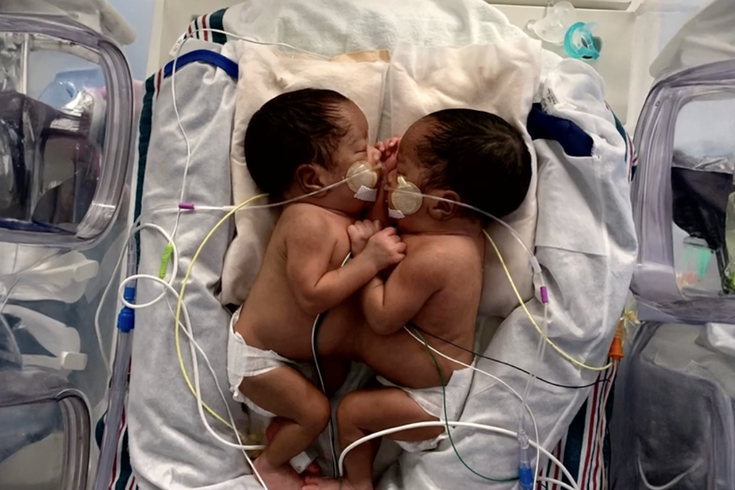
October 09, 2024
 Provided Image/CHOP
Provided Image/CHOP
Conjoined twins Amari and Javar Ruffin are shown above before they underwent an 8-hour surgery in August to separate them at Children's Hospital of Philadelphia. The boys were joined at the liver, sternum and abdominal walls.
Children's Hospital of Philadelphia surgeons recently separated conjoined twin boys who were born last year with a shared liver, sternum and abdominal walls. The boys had been born more than two months early and spent over a year in the hospital before going home this week, about two months after their surgery in August.
Parents Tim and Shaneka Ruffin learned they were going to have twins at 12 weeks into Shaneka's pregnancy. A routine ultrasound revealed there were two heartbeats. Further testing confirmed the babies were conjoined facing one another.
MORE: Baby boomers are living longer than previous generations, but they have more health problems
The West Philly family initially was advised to consider terminating the pregnancy to avoid potentially life-threatening complications for Shaneka and her two boys, Amari and Javar. Conjoined twins are extremely rare, occurring once in every 35,000 to 80,000 births. They occur when a woman produces a single egg that doesn't separate completely after it is fertilized.
"You don't know where to go from there when you've never experienced this," Shaneka said in a video CHOP produced about the family's journey.
The Ruffins decided they wanted to explore their options and scheduled a consultation at CHOP. The hospital has completed 32 surgeries to separate conjoined twins since 1957, more than any other hospital in North America.
Tests confirmed the two boys' chests and hearts were not joined, and that each of their hearts had normal structure and function. Although they were joined at the liver, Amari and Javar each had roughly equal-sized portions of the organ that would be able to thrive independently. The liver is the largest internal organ in the body, responsible for filtering blood and aiding in digestion.
"We told them that first day that things looked favorable for separation," Dr. Holly Hedrick, a pediatric surgeon at CHOP, said in the video.
When the boys were born at CHOP in September 2023, they weighed a combined six pounds. They had to spend 10 months in the hospital preparing for separation while they underwent otherwise normal stages of infant development.
Shaneka said she felt a "disconnect" while her twins were in the hospital, because she couldn't experience motherhood with them at home with the Ruffins' two other kids. CHOP provided mental health counseling as part of the process leading up to the surgery to help the family cope.
"You put on a front and a smile, like 'Oh, these are my babies,' but inside you're screaming like, 'What is going on?'" Shaneka said.
The surgery to separate Amari and Javar on Aug. 21 lasted eight hours. The boys were first divided from one another and then underwent individual surgeries to preserve the function of their livers and contain their internal organs with a layer of absorbable mesh. Plastic surgeons then worked to expand their skin across their abdomens and create belly buttons for each of the boys.
Babies who are born conjoined face significant risks, including stillbirth. They have an overall survival rate of just 7.5%, and only 60% of those surgically separated survive, according to the National Institutes of Health. About three-quarters of conjoined twins are connected at least partially at the chest and share some organs. Outcomes for surgery are generally better the fewer organs the infants share. Survival is extremely rare when surgery is performed on twins who are connected at the heart.
Amari and Javar remained in the hospital after their recoveries to work with physical therapists, occupational therapists, speech language pathologists and rehab medicine physicians to prepare them for developmental milestones. They went home with their parents Tuesday and will continue to have weekly follow-up care at CHOP.
"Seeing them each in their own beds was an indescribable feeling," Shaneka said. "It feels like we are beginning a new journey as a family of six. We are so grateful to CHOP for helping make this day possible and letting us start this next chapter."
Dr. Nahla Khalek, a maternal fetal medicine specialist at CHOP, said the Ruffins' story speaks to the power of giving patients a full spectrum of care.
"I think it's incredibly important to respect and empower patients and their families by offering them a level of education and assessment where even if we can't change the scenario, they at least feel empowered enough that they can make informed decisions about their pregnancy," Khalek said in the video.